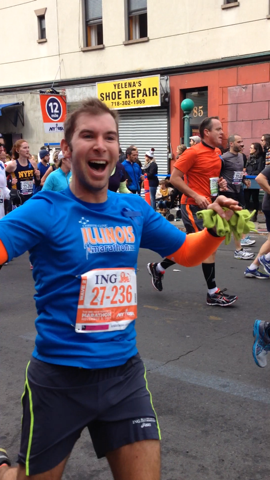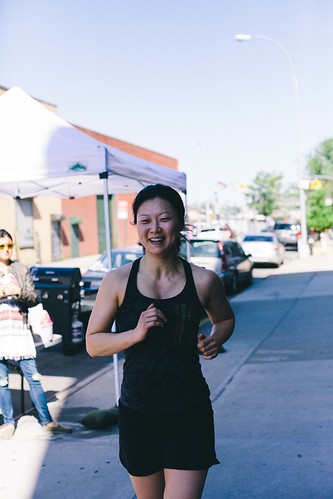Fitness:
Deadlift to Knee + Below the Knee Power Clean + Front Squat
Hold the catch position after the BTK Pr Clean, then finish the squat portion. Take that moment to reogranize your finish if necessary.
Performance:
Work up to a heavy single on the Below the Knee Power Clean
Front Squat
Fitness: 3×3 Across
Add 5lbs from last week
Performance: Work up to a heavy double
Post loads to comments.
CLN FSQ e 5/6
______________________
NFT:
50 Kettlebell Swings + 2 laps around the block
Choose a heavy weight and try to perform this in 2-3 sets. Focus on a consistent and powerful swing.
 Rob U + the fam during the NYC Marathon. Nice sticker usage!
Rob U + the fam during the NYC Marathon. Nice sticker usage!
Gym Etiquette
By Coach Noah
In the early days of Crossfit, long before Reebok, before Inov-8, heck, back when aspiring Firebreathers still weighed their half baloney sandwiches before consumption, Crossfitters were a prim and proper bunch. Donning their finest finery, they silently performed their WODs, cleaned up their mess, quietly clapped for their peers, and then pedaled back home on their giant-front-wheeled bicycles to wax their mustachios. Ah, the Golden Age of Crossfit.
I kid, I kid. There never was such a time- Crossfit is inherently an inexact, sweaty, bloody science. Every day we push ourselves to our limits, possibly redistribute prior meals into garbage receptacles, and generally use our time in the gym to blow off steam, aggressively pursue our own goals, and most importantly, have fun.
That being said, there is a place for some etiquette within the gym. Rather than add a 9th class onto Foundations, where fledgling CrossNoobs learn how to balance books on their head while breaking down barbells, please bear with me for a mostly philosophical, no-nuts, no-bolts treatise on how to be a model citizen in our little exercise utopia.
Equipment and Environment
One of the biggest reasons people join Crossfit gyms is for all the wonderful toys available to punish ourselves with. Bumper plates, rings, Prowlers- most of this equipment is rarely glimpsed in the Globo Gym world, often pushed over in a corner, collecting cobwebs. At CFSBK, and gyms across the multiverse, owners pride themselves in keeping their equipment up to date, in working order, and constantly searching for the newest and best equipment money can buy.
Notice I said “money.” Crossfit equipment is freaking expensive! With that in mind, please be a gentle custodian of the equipment you use at the gym. Obviously, we would never bail an unloaded barbell, but our stewardship can continue further- not bailing weight unless absolutely necessary, not testing the precise tensile failure of bands, and so on. Although our equipment can take quite a beating, it isn’t indestructible- treating it with loving care will allow it to last much longer, and free up that moolah for buying Shake Weights.
Also, please try and wipe down sweat, blood (!!!!), and any other detritus you expel during your athletic endeavors. That’s nasty.
We normally put our equipment away after doing things to our bodies most people would deem cruel and unusual. We’re tired, shaky, and thinking about the Bierkraft Paleo Special we are soon to devour (that’s a plug Ben, ahem, ahem.) Please, please take a second to try and put things where they belong and make sure you return every implement you used. Bumper plates haphazardly stacked like rims at a shady tire shop, dumbells thrown under the shelf with no care for David’s precisely charted pyramid stacking scheme, bands left hanging like lonely noodles- every time this happens a WOD Angel loses its wings. This applies further to the larger environment of the gym- most of us spend a solid chunk of our week here. Treat it like home, and keep it clean and tidy like its home, and it will feel like home. Just to be clear, no, you cannot sleep under the kettlebells if you don’t pay your rent.
People
I’ve spent far too long talking about inanimate objects (although I believe that 2 Pood Kettlebells do possess the souls of demons.) Let’s talk about the most important element at any Crossfit gym- people! Our stalwart daily compatriots, our classmates have seen us through hard fought reps, scary bails, and triumphant PR’s. We are a brother and sisterhood bound by the unbreakable smell of sweaty socks, and we must treat each other accordingly. After you yell “TIME,” take a second, re-swallow your lunch, and then start your 2nd WOD- cheering others on. You don’t have to quote epic poems of heroic struggle, read excerpts of Patton’s speeches, or attempt technical cheerleading formations. Simple “yeahs!” “go’s!” and “Get it’s!” suffice. If you have caused such irreparable harm to your central nervous system that you can no longer talk, just clap. When you do a WOD, the whole gym is a team. Cheer for your teammates, and don’t leave before every single person who started the WOD is done. Unless you have really caused irreparable CNS damage- you might want to see a doctor about that.
Be mindful of people working out as you’re in the gym. Don’t walk across the field of vision of someone chasing a 1RM clean or narrowly avoid someone squatting heavy while going to get a kettlebell. This is distracting and frustrating for the lifter, and can be avoided by simply taking your time and being mindful. The gym is a busy place, but try your best to not disrupt others as you go about getting your swell on.
Lastly, an important element of being a noble Crossfitter is to be honest about your work and effort. Cutting corners, whether it be in partial ROM reps or shorting your rep counts, hurts your fellow gym members by distorting their data, but more importantly stunts your growth. Remember, if you can’t remember if you’ve done 14 or 24 reps, assume its 14- you’ll only be 10 extra reps stronger at the end. Treat each rep as an opportunity to show how good you are at the movement, perform them correctly before you perform them quickly, and don’t take a call of “missed rep” or a coach asking you to drop weight as a personal condemnation. The members at CFSBK are better at this than almost any other gym I’ve ever seen, but it still bears repeating- be your own strictest judge, and hold yourself to the highest standard of personal virtuosity.
In sum:
– Put your equipment away in its place after you’re done
– Cheer on fellow CrossFitters when you’re done with your own workout
– Don’t unnecessarily abuse the equipment
– Mind others space and field of vision, especially when they’re lifting heavy.
– Don’t short reps
– Practice Technique and consistency before technique
– Listen to your coaches, we’re working in your best interest.
Consider this etiquette lesson complete! You can stop balancing the book on your head, and don’t worry about which fork goes on which side while you do your burpees. Simply treat your equipment, facilities, and, most importantly each other, with care and kindness. Huzzah!
____________________
Top 10 Mistakes CrossFitters Make The Tabata Times








